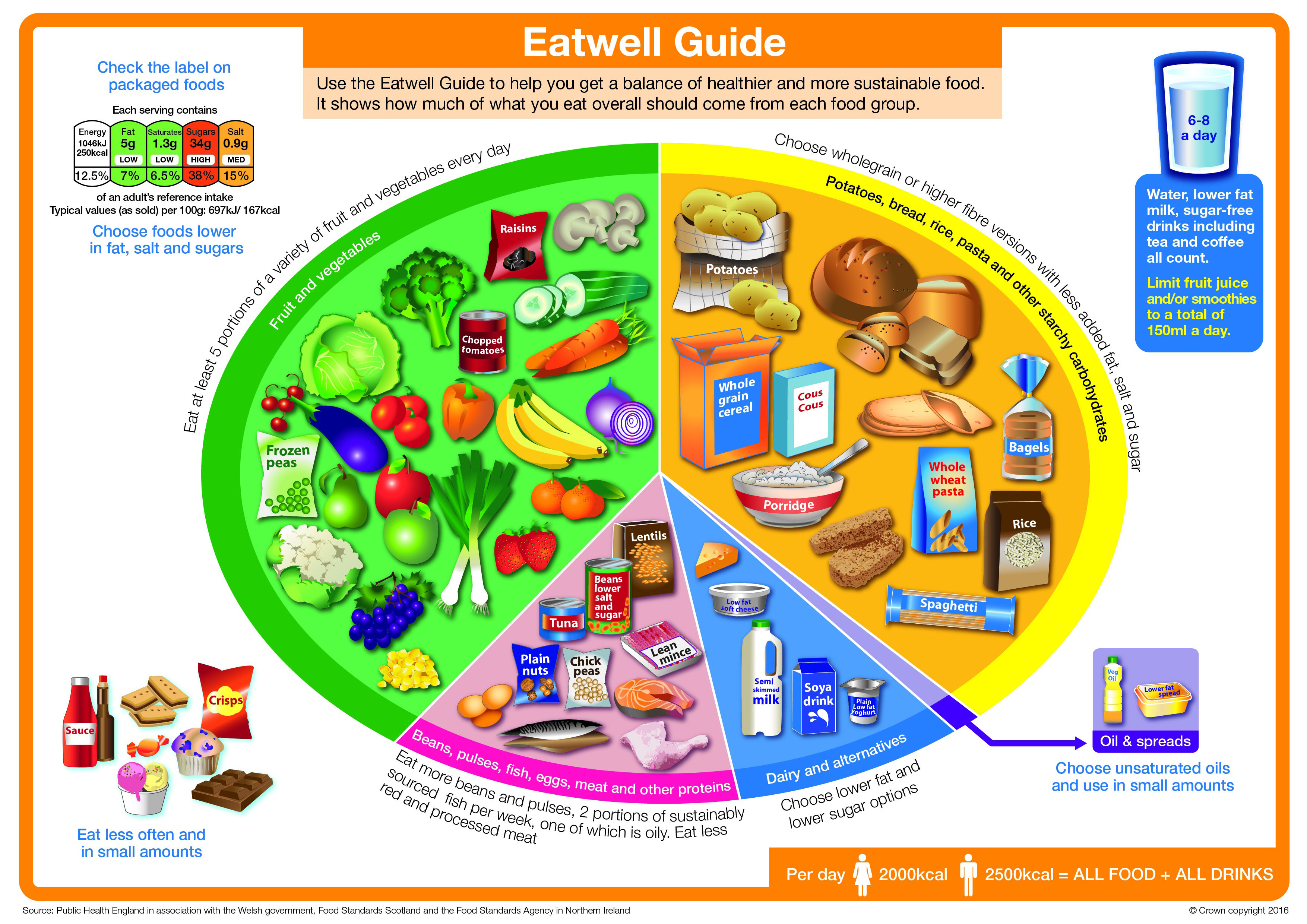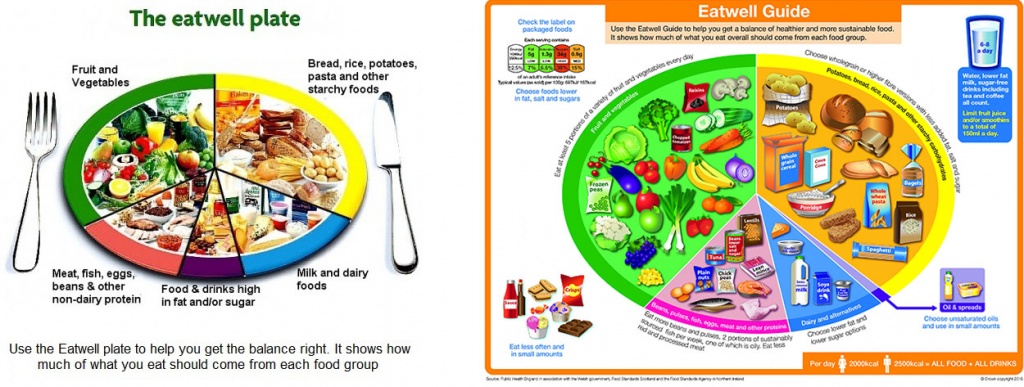Kept under much secrecy, the government revealed the updated Eatwell Plate to the nation on Thursday 17th March following a stakeholder meeting on Wednesday 16th , which we were pleased to attend. Surprising for us, the changes to the new Eatwell Guide went beyond some simple cosmetic adaptations. In the main, the plate, based on exhaustive reviews of the scientific evidence, has embraced more of the 21st Century consumer eating trends and the growing concerns around sustainability. Will it be more effective at improving the population’s poor nutritional status and reduce obesity? As with all dietary guidelines, effective communication and behaviour change strategies that follow will be key.
The official documentation lists 12 differences, however, we’ve added one more!
- Importance of hydration has finally been embraced! With recommendations to consumer 6-8 glasses of fluid daily: water, sugar free drinks including tea and coffee and milk.
- Front of pack labelling: possibly coming to terms that as much as we would love the nation to be keen cooks, ready meals and take-aways are by far more popular.
- High fat, salt and sugar foods removed altogether: ‘no role in a healthy balanced diet.’ At last, the group that also included healthy unsaturated fat oils and spreads has been better clarified with latter remaining within the Eatwell Guide as a much smaller section (taking up just 1%).
- Calories have been included for adult men and women – to remind consumers that all foods contribute to calories.
- Four of the five food segments renamed: changing the emphasis to embrace more wholegrains and plant foods whilst keeping saturated fat down.
• Bread, rice, potatoes pasta and other starchy foods is now ‘Potatoes, bread, rice, pasta and other starchy carbohydrates’ with an overarching sub-line ‘Choose wholegrain or higher fibre versions with less added fat, salt and sugar.’
• Milk & dairy foods is now ‘Dairy & alternatives’ with the sub-line ‘Choose lower fat and lower sugar options.’
• Meat, fish, eggs, beans and other non-dairy sources of protein is now ‘Beans, pulses, fish, eggs, meat and other proteins’ with the sub-line ‘Eat more beans and pulses, 2 portions of sustainably sourced fish per week, one of which is oily. Eat less red and processed meat.’
• Food and drinks high in fat, sugar and/or salt has now been removed and instead replaced with ‘Oil & spreads’. - The five food segments re-sized:
• Fruit and vegetables – go up by 7%, now making up 40% of the plate.
• A bigger push for wholegrain carbs – and up by 5% to 38% of the plate. We hope this will help towards the fight against the ‘anti-carb-based on dodgy and misinterpreted science’ brigade. – As well as wholegrain, there is more emphasis (we feel within the full guidance notes) that it’s not carbs that are fattening but what we choose to add to them.
• Dairy and alternatives – almost halving the recommendations from 15% down to just 8% of the plate. We are pleased to see calcium fortified and unsweetened dairy alternatives making a bigger noise here. And interestingly, 1% dairy milks are recommended over semi-skimmed.
• Protein segment making up the same proportion as previously, has significantly been revamped to embrace sustainability and the need for more plant-based protein consumption. With ‘other proteins’ including soya and Mycoproteins. Single portions of meat to be 70g and fish to be sustainably sourced. - Fruit juice removed from the Eatwell Guide fruit and vegetable visual in this sector, but highlighted in the hydration section with a significant emphasis that no more than 150ml daily consumption.
- Smoothies have lost their halo: previously, smoothies were permitted to count as 2 of our 5-a-day at 125ml per portion. With both smoothies and fruit juice now classified as ‘free sugars’ the consumption of either has been clearly limited to no more than 150ml per day as part of hydration and contributing to just one of our 5-a-day.
- Oils and spreads: now making just 1% of the Eatwell Guide and thankfully no longer considered as part of the high fat, salt and sugar foods. There is good emphasis within the guidance that all fats however add cals and should be limited.
- Additional messages for further guidance – helping consumers better understand the visuals including 8 tips for healthy eating.
Some changes based on qualitative stakeholder and consumer insights, but considered more cosmetic by us: - No fork and knife
- Change of name from Eatwell Plate to Eatwell Guide
• Both the above changes based on insights that they little reflect how consumers see meals / consume foods. - Drawn food images rather than photography. Interesting insight that although stakeholders prefer the latter, consumers prefer the former.
Great strides – but will it be enough?
We are disappointed that there continues to be no offer of practical and household portion guides particularly for the carbohydrate and some foods from the protein groups. This will make it difficult for both the consumers and health advisors to provide the real practical much needed approach. We appreciate that it is a challenging task but believe it to be achievable. As Dietitian communicators in public health we are aware of how much the public needs to be shown how to put these guidelines into practice and how much a consistent approach is needed. PHE at the stakeholder meeting mentioned that they have done some preliminary work on this internally but such things like meal plans will not currently feature in the tools and communications, due largely to lack of funding. We were also surprised that no quantitative survey work representative of the population and health advisers using the tool had not been undertaken prior to the focus group work. Perhaps if this had been done these needs would have been prioritised and addressed.
Will this change the health of the nation?
It will all depend on how and who it’s communicated to and what behaviour change strategies will be put into place which as we all know, means funding. With Cameron’s Obesity Strategy expected to be announced in 2016, how much funding is put behind such campaigns will be the true sign of how seriously they are about tackling the health of the nation.


